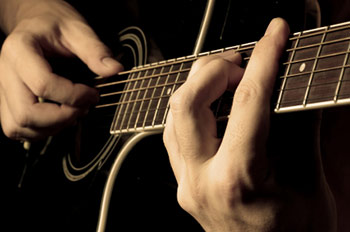
While one can certainly appreciate the electric guitar for a wide variety of reasons, for me, and probably a great deal of other guitarists, the aspect that really separates the electric guitar are the loud, thundering guitar riffs that are often composed from power chords.
You got the power!
Power chords are, without debate, the signature of modern rock, grunge rock, hard rock and metal (NOTE: If you are a true beginner and are not sure what I am talking about, peep the opening riff to Deep Purple “Smoke on the Water” for a classic example).
The interesting thing about power chords is although they are organized into the chords category they are technically not a “chord”. Why? In music and music theory, a chord is three or more different notes that are sounded simultaneously. They are further broken down into “Major” or “Minor” Triads. However, a power chord is an abbreviated version of the full triad chords playing only the root and fifth notes of the scale as a chord. In other words, it’s not technically a “chord” because it only has two notes.
Due to one less note, most beginners would assume that power chords are easier to play. While true in theory, the importance of learning music theory should not be de-emphasized. In order to learn power chords effectively, you will NEED to really understand the names of the notes on the neck of the guitar.
Interesting enough, power chords have a history that dates back to the birth of blues music although the guitar technique was probably not fully realized and used effectively until the 90s grunge era. At that time, most bands relied on power chords almost exclusively, as they were simply easier to play and more appropriate for the genre when compared to “traditional chords”.
Power chords are incredibly versatile in the sense that you can literally move them up and down the guitar neck. This is not possible with regular chords, therefore giving it yet another distinct advantage. Again, this is where your knowledge of the note locations on the guitar neck will really come in handy.
Remember: Each power chord only contains two notes — the root note and another note called the “fifth”. The power chord does NOT contain the note which traditionally tells us whether the chord is major or minor. Consequently, power chords are neither defined as major or minor chords.

Additional notes:
- Guitarists may optionally omit the pinky finger on a power chord to strum the two-note chord we discussed (above). However, some guitarists will still stick with the full, three-note version as it tends to sound more “full”.
- Another common technique for three-note power chords is to play the root note with the first finger and then let the third finger cover the other two notes. As a result, still only two fingers are technically needed.
- Power chords ideally sound best with moderate to maximum distortion, although personal preferences may differ.
